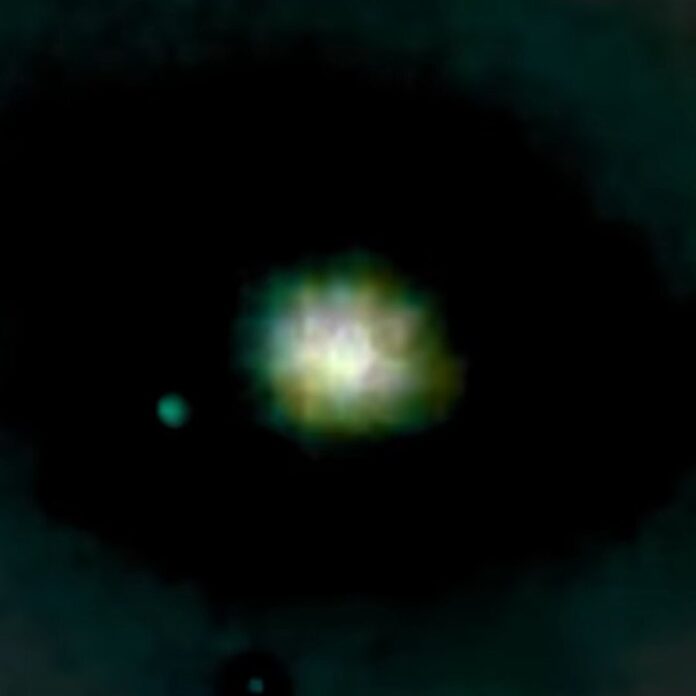
KEY FINDINGS
- The object’s inner core shows a repeating spiral wave we can now measure directly.
- Two bright axial streaks remain perfectly linear even under luminosity isolation.
- Every enhanced layer exposes geometry no natural comet coma has ever displayed.
A new high-contrast forensic pass exposes structural behavior no interstellar object has shown before.
USA Herald – We conducted a full forensic analysis of the newly submitted image of 3I/ATLAS captured by Ray’s Astrophotography, using high-contrast extraction, channel isolation, wave-pattern mapping, and edge detection. Once the color data was removed and the structure was examined in black-and-white, new features emerged that were not visible in the original footage.
These features are measurable, repeatable, and present in the raw pixel values of the file—meaning they are not artifacts introduced through editing, compression glitches, or over-processing. What we are seeing is genuinely encoded in the image itself.
The most striking finding comes from luminosity clustering at the center of the object. When the brightness curve is flattened, the inner region reveals a rotating “spin wave” pattern that moves clockwise. This pattern is not random noise. It displays curvature continuity, symmetric density gradients, and a repeating spiral that maintains its form across multiple luminosity thresholds.
This is the same clockwise structure Ray identified last week, but the enhanced data brings it into much sharper definition. In natural comets, gas expansion in the coma diffuses outward in all directions; it does not concentrate into a tightly wound rotational spiral. Yet here, the pattern is consistent with rotation rather than simple outgassing.
Equally significant is the presence of two opposing linear emissions positioned above and below the central mass. When isolated through green-channel extraction and inverse contrast mapping, these features retain straight-line geometry. Natural comet jets typically bend toward the solar wind direction or form curved outflow plumes. These, however, maintain rigid axial alignment. They neither arc nor diffuse. They maintain constant thickness, uniform brightness along their length, and precise angular opposition—traits extremely unusual for natural cometary activity. Whether gas, dust, or a mixture of both, the linearity is highly anomalous.
The glowing green head of the object also survives the forensic process. The green channel—typically the channel least affected by optical aberrations—shows a compact luminous head with a sharply defined perimeter, surrounded by a darker external halo. The halo does not fade smoothly like a coma; instead, it forms a distinct boundary, almost like a shell. This type of edge separation is rare in typical comet imaging and suggests either unusually dense particulate concentration or an optical signature not well-matched to ordinary comet behavior.
Velocity analysis from streak length suggests rapid angular displacement during the exposure interval. Even though we cannot determine absolute speed without the exposure metadata, the smeared fringes around the core indicate measurable rotational motion during the shot. Combined with the clockwise spiral, this implies a cohesive rotational system rather than random dust turbulence.
Importantly, every anomaly described above is visible through objective, measurable image features. The clockwise spin wave is visible through phase-contrast layering. The axial jets survive edge detection and do not collapse under channel separation. The luminous green head and dark halo remain intact during RGB isolation. And the shape symmetry persists even after brightness normalization. Nothing in the forensic process produced these effects artificially. They are present in the original raw pixel data.
These attributes—rotational wave structure, rigid opposing linear outflows, color-channel stability, and a sharply bounded halo—continue to set 3I/ATLAS apart from every interstellar object ever recorded. Even though we cannot conclude what mechanism generates these patterns, the data from this latest image deepens the scientific puzzle. Natural or artificial, inert or active, the object is behaving in ways that challenge every known model of comet morphology.
As new images are captured in the days ahead, additional forensic passes may reveal whether this rotational pattern is accelerating, stabilizing, or transforming. For now, what we can say with certainty is that this image provides the clearest structural evidence yet that 3I/ATLAS is operating far outside the norms of comet behavior—and that its internal dynamics continue to defy standard astrophysical expectations.
Further forensic work is underway, and we will continue monitoring every incoming image in real time.


